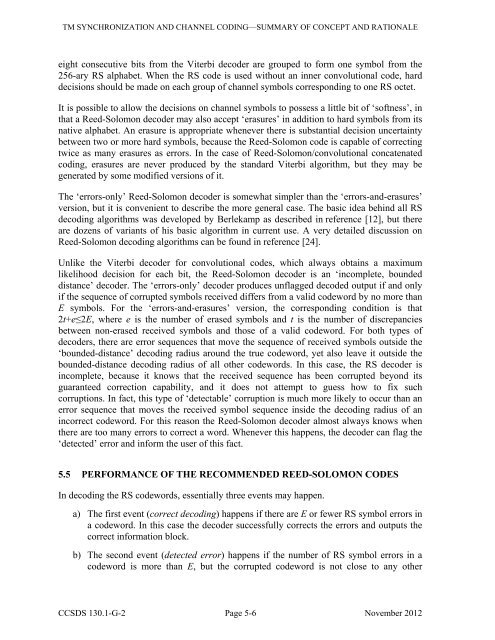130x1g2 - CCSDS
130x1g2 - CCSDS
130x1g2 - CCSDS
You also want an ePaper? Increase the reach of your titles
YUMPU automatically turns print PDFs into web optimized ePapers that Google loves.
TM SYNCHRONIZATION AND CHANNEL CODING—SUMMARY OF CONCEPT AND RATIONALEeight consecutive bits from the Viterbi decoder are grouped to form one symbol from the256-ary RS alphabet. When the RS code is used without an inner convolutional code, harddecisions should be made on each group of channel symbols corresponding to one RS octet.It is possible to allow the decisions on channel symbols to possess a little bit of ‘softness’, inthat a Reed-Solomon decoder may also accept ‘erasures’ in addition to hard symbols from itsnative alphabet. An erasure is appropriate whenever there is substantial decision uncertaintybetween two or more hard symbols, because the Reed-Solomon code is capable of correctingtwice as many erasures as errors. In the case of Reed-Solomon/convolutional concatenatedcoding, erasures are never produced by the standard Viterbi algorithm, but they may begenerated by some modified versions of it.The ‘errors-only’ Reed-Solomon decoder is somewhat simpler than the ‘errors-and-erasures’version, but it is convenient to describe the more general case. The basic idea behind all RSdecoding algorithms was developed by Berlekamp as described in reference [12], but thereare dozens of variants of his basic algorithm in current use. A very detailed discussion onReed-Solomon decoding algorithms can be found in reference [24].Unlike the Viterbi decoder for convolutional codes, which always obtains a maximumlikelihood decision for each bit, the Reed-Solomon decoder is an ‘incomplete, boundeddistance’ decoder. The ‘errors-only’ decoder produces unflagged decoded output if and onlyif the sequence of corrupted symbols received differs from a valid codeword by no more thanE symbols. For the ‘errors-and-erasures’ version, the corresponding condition is that2t+e≤2E, where e is the number of erased symbols and t is the number of discrepanciesbetween non-erased received symbols and those of a valid codeword. For both types ofdecoders, there are error sequences that move the sequence of received symbols outside the‘bounded-distance’ decoding radius around the true codeword, yet also leave it outside thebounded-distance decoding radius of all other codewords. In this case, the RS decoder isincomplete, because it knows that the received sequence has been corrupted beyond itsguaranteed correction capability, and it does not attempt to guess how to fix suchcorruptions. In fact, this type of ‘detectable’ corruption is much more likely to occur than anerror sequence that moves the received symbol sequence inside the decoding radius of anincorrect codeword. For this reason the Reed-Solomon decoder almost always knows whenthere are too many errors to correct a word. Whenever this happens, the decoder can flag the‘detected’ error and inform the user of this fact.5.5 PERFORMANCE OF THE RECOMMENDED REED-SOLOMON CODESIn decoding the RS codewords, essentially three events may happen.a) The first event (correct decoding) happens if there are E or fewer RS symbol errors ina codeword. In this case the decoder successfully corrects the errors and outputs thecorrect information block.b) The second event (detected error) happens if the number of RS symbol errors in acodeword is more than E, but the corrupted codeword is not close to any other<strong>CCSDS</strong> 130.1-G-2 Page 5-6 November 2012

















